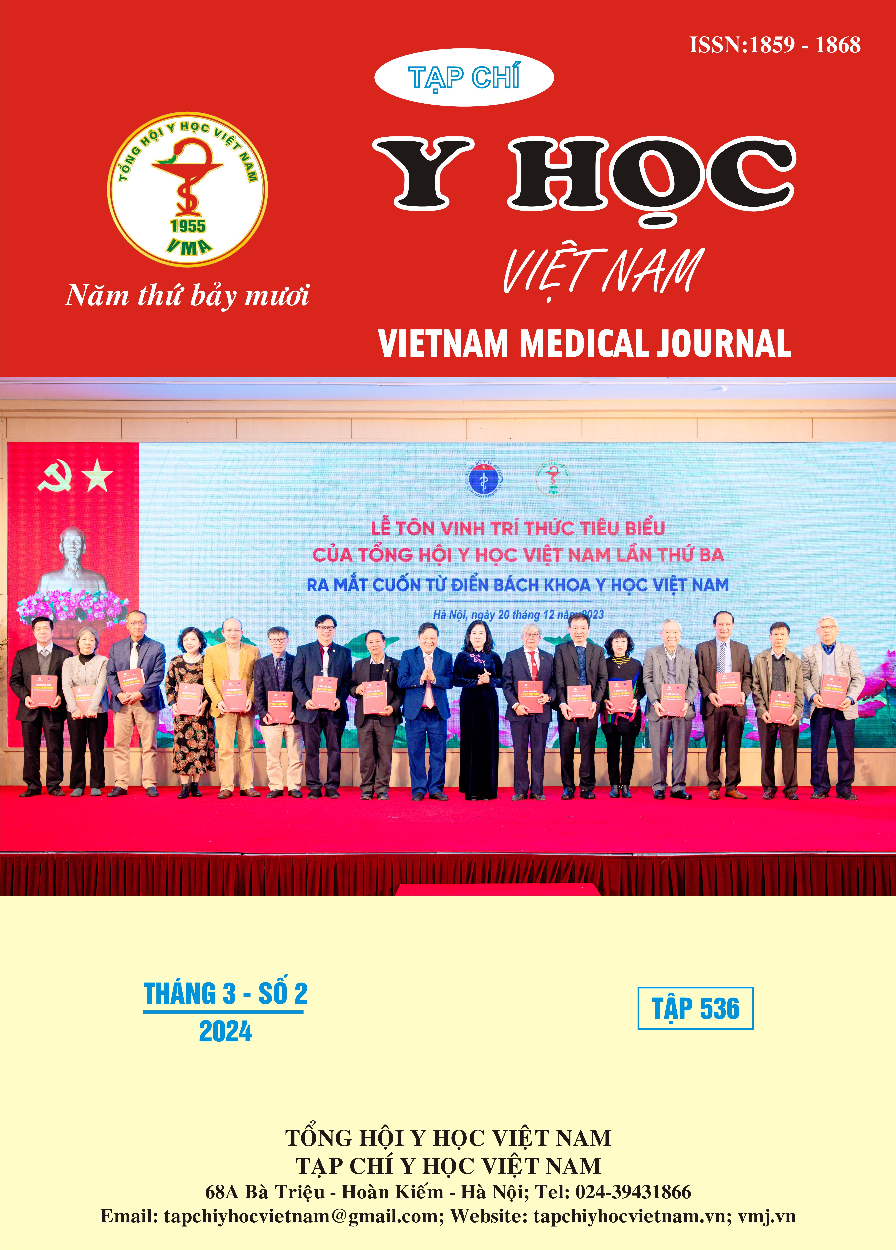LAPAROSCOPIC URETEROLITHOTOMY FOR URETERAL STONES AT HANOI MEDICAL UNIVERSITY HOSPITAL
Main Article Content
Abstract
Objective: Evaluate the results of retroperitoneal laparoscopic ureterolithotomy for ureteral stones at Hanoi Medical University Hospital. Research subjects and methods: cross-sectional, retrospective description of 40 patients with confirmed diagnosis of ureteral stones and retroperitoneal laparoscopic surgery to remove stones at Hanoi Medical University Hospital from January 2020 to November /2023. Results: 40 patients included 31 men (77.5%) and 9 women (22.5%). The average age was 54.18 ± 9.82 years old. (37 – 72 years old). Average surgery time was 70.0 ± 23.5 minutes. 100% success. Complications during surgery: 2 patients with peritoneal tear (5.0%), 1 patient with gonadal vein bleeding (2.5%), 2 patients with subcutaneous emphysema (5.0%). The average number of days in the hospital after surgery was 3.52 ± 1.1 days. Early complications after surgery: 1 patient had urine leakage, 1 patient had bleeding through drainage in a patient who restarted anticoagulation early. Conclusion: Laparoscopic retroperitoneal surgery to remove ureteral stones is a minimally invasive, safe and effective method for upper 1/3 and middle 1/3 ureteral stones.
Article Details
References
2. Brener ZZ, Winchester JF, Salman H, Bergman M. Nephrolithiasis: evaluation and management. South Med J. 2011;104(2):133-139.
3. Mousavi Bahar SH, Amirhassani S, Nouralizadeh A, ZerafatJou N, Rasiuli J. Percutaneous Nephrolithotomy Versus Laparoscopy in the Management of Large Proximal Ureteral Stones: The Experience of Two Different Settings. Urology Journal. 2019;16(5): 448-452.
4. Deng T, Chen Y, Liu B, et al. Systematic review and cumulative analysis of the managements for proximal impacted ureteral stones. World J Urol. 2019;37(8):1687-1701.
5. Trần Văn Hinh. Giải phẫu hệ tiết niệu. Các phương pháp chẩn đoán và điều trị sỏi tiết niệu. Nhà xuất bản Y học. 2013:9-24.
6. Wani MM, Durrani AM. Laparoscopic ureterolithotomy: Experience of 60 cases from a developing world hospital. Journal of Minimal Access Surgery. 2019;15(2):103-108.
7. Raheem AA, Alowidah I, Althagafi S, Almousa M, Alturki M. Laparoscopic ureterolithotomy for large ureteric stones: tips and tricks. Central European Journal of Urology. 2020;73(3):389-390.
8. Wang K, Wang G, Shi H, et al. Analysis of the clinical effect and long-term follow-up results of retroperitoneal laparoscopic ureterolithotomy in the treatment of complicated upper ureteral calculi (report of 206 cases followed for 10 years). International Urology and Nephrology. 2019; 51(11):1955-1960.
9. Vương Xuân Thủy. Đánh giá kết quả điều trị sỏi niệu quản 1/3 trên bằng phẫu thuật nội soi ngoài phúc mạc tại bệnh viện Việt Đức giai đoạn 2007-2009. Luận văn Thạc sỹ, Trường Đại học Y Hà Nội, Hà Nội. 2010.
10. Kumar A, Vasudeva P, Nanda B, Kumar N, Jha SK, Singh H. A Prospective Randomized Comparison Between Laparoscopic Ureterolithotomy and Semirigid Ureteroscopy for Upper Ureteral Stones >2 cm: A Single-Center Experience. Journal of Endourology. 2015;29(11): 1248-1252.


